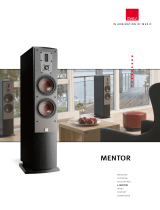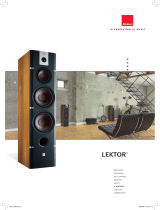Page is loading ...

OWNERS MANUAL

THANK YOU FOR
CHOOSING DALI
We know you cant wait to hear your new DALI loudspeakers, so well save the more
technical stuff until later. That way, youll have something to read once your system is up
and running.
But first, unless you are experienced and confident in hi-fi matters, please take the time to
read at least the sections on CONNECTIONS and PLACEMENT, before wiring your new
DALI loudspeakers to your system.
It is the goal of this manual to assist you in obtaining the finest possible performance from
your new DALI loudspeakers. If additional assistance is required, always feel free to contact
your authorised DALI dealer.
STEREO AND SURROUND
CONNECTION
The loudspeaker carton indicates whether the
speaker inside is Left or Right or Centre. Position
them correctly.
Always turn your amplifier off before connecting
or disconnecting any cables. Always use equal
lengths of cable for the left and right speakers.
Cable should be connected between loudspeaker
and amplifier, red plus (+) terminal to red plus (+)
terminal and black minus (-) terminal to black mi-
nus (-) terminal. It is important that the connections
are made correctly and in phase. Incorrect, out-
of-phase connection will result in a diffuse stereo
image and weak bass.
Your DALI Evidence loudspeakers have two pairs
of terminals. If you do not choose to use bi-wiring
or bi-amping, make sure that the enclosed metal
straps are in place and tightened by hand, one
connecting red terminal to red terminal, the other
connecting black terminal to black terminal. For
normal use, connect only one terminal pair to the
amp as shown in (Fig. 1).
In a surround system, connect centre, front and
rear surround loudspeakers to the surround amp
as shown in (Fig. 2).
Fig. 1. Normal Stereo Connection
Fig. 2. Surround Connection
2

BI-WIRING AND BI-AMPING
We recommend bi-wiring or bi-amping for
improved sound quality.
To bi-wire or bi-amp, remove the metal straps
before going on to the next steps. The top termi-
nal pair on each speaker connects to the high
frequency crossover section and the bottom ter-
minal pair connects directly to the low frequency
crossover section.
To bi-wire (fig. 3), connect cable from one pair of
terminals on each speaker to the amplifiers out-
put terminals. Then, connect another cable from
the second pair of speaker terminals to the SAME
terminals on the amplifier.
To bi-amp (fig. 4), two identical stereo amplifiers
should be used. Connect cable from the bass
terminals of the left speaker to the left channel of
one of the amplifiers. Connect cable from the
bass terminals of the right speaker to the right
channel of the same amplifier.
Connect cable from the high frequency terminals
of the left speaker to the left channel of the second
amplifier. Then, connect cable from the high
frequency terminals of the right speaker to the
right channel of the second amplifier.
Bi-wiring offers improvements in the areas of
openness and reduces intermodulation distort-
ion. Bi-amping offers further improvements in
these areas with the added benefit of increased
dynamics.
Tighten all connections securely so that the cable
cannot slip out. Make certain that no loose
strands of wire are sticking out. Wire connected
to a terminal must never touch wire connected
to any other terminal.
3
Cable quality and design do make a difference. Buy the best cable you can reasonably
afford. In this simple way, you can raise the performance of your system to a higher level.

PLACEMENT
Fig. 5. Ideal height for listening
Fig. 6. Centre speaker placement
Fig. 7. Placement of stereo/surround
front speakers
Even small differences in the positioning of
loudspeakers in a room can have significant
impact on performance, especially on soundstage
focus and bass quality.
DALI loudspeakers are capable of exceptional
performance in these and other crucial areas, but
you must experiment with placement in order to
find the optimum position.
Unfortunately, there are no hard and fast rules to
follow, but here are a few guidelines.
There should be no objects between the speakers
and the listening position. Obstructions to the free
passage of sound cause uneven frequency
response and poor stereo imaging.
The distance between the Left and Right speaker
and between each speaker and the central
listening position should be identical. While DALI
loudspeakers provide excellent performance at
positions off to the side, for serious, critical
listening we strongly recommend a central
listening position.
DALI loudspeakers should face directly ahead,
with no toe-in (Fig. 7).
The DALI Evidence centre speaker is specifically
tuned for placement near the large, flat surface
of a TV screen. The DALI centre speaker should
be placed directly above or below the television
with the speakers front edge along the same line
as the TV screen (Fig. 6).
The front panel of the DALI centre speaker should
be along the same line as the front panels of your
left and right front speakers as seen in (fig. 7).
4

THE LISTENING ROOM
Your DALI loudspeakers have been designed to
convert the incoming electrical signal to acoustic
energy as accurately as possible. But speakers
are only one link in the audio chain which begins
with the quality of the recorded material, the
turntable/CD player/tuner/tape player signal
source, interconnects, the amplifier, speaker
cables and finally ends with the listening room
itself.
Loudspeakers perform best in rooms with normal
furnishings such as bookshelves, flowers, vases,
and soft furniture. Removing a vase, opening a
curtain slightly or moving a chair a few inches can
actually make a big difference. Try to avoid large,
hard, flat surfaces near the speakers.
If the sound is on the bright side, closing curtains
may help. The heavier the curtain, the greater the
effect. Rugs or carpets will damp unwanted
reflections from a hardwood floor.
The quality and quantity of bass depend on the
size and shape of the room. Experiment with
various positions. Bass will be reinforced by
placement near side or rear walls, so, naturally,
corner placement offers substantial bass boost.
Find the position that offers the best balance of
sound for your room and musical tastes.
When you have found the best position, make
certain that the loudspeaker is perfectly level and
cannot rock back and forth. Spikes may be used
to couple the speaker more effectively to the floor.
Spikes are especially recommended on surfaces
with thick carpeting. Spikes will generally tighten
up bass response and sharpen up the focus of
the stereo image.
5

POWER HANDLING
The power handling of a loudspeaker is very much
dependent on the type of music it is called upon
to reproduce at any given time. Since a music
signal or film soundtrack simultaneously consists
of a broad range of frequencies, it is not possible
to define maximum power handling in meaningful
terms.
In the real world, large amounts of clean,
undistorted power from a big amp is better than
the distorted output of a small amp pushed beyond
its limits. More speakers are damaged by small
amps working too hard, than by big amps coasting
along.
Turning tone controls up beyond their neutral cen-
tre position greatly increases power demands.
Tone controls are intended for occasional use to
improve older recordings or bad recordings. We
strongly advise against using them to compensate
permanently for weaknesses elsewhere in the
audio system. Experimenting with loudspeaker
placement may be all it takes to achieve a much
more musical result.
Under normal conditions, overloading is heard as
distortion (clipping) and a loss of clarity. If you
always keep the level below this point, there will
be nothing to worry about.
SURROUND SOUND
Adjusting surround levels
Follow the instructions included with your surround amplifier, match power levels so that
all speakers sound equally loud at the listening position. An accurate Sound Pressure
Level metre will make system calibration easier and more precise.
6

DYNAMICS
Unfortunately, too much attention is focused on the ability to play LOUD. Much more
important for your musical and cinematic enjoyment is the ability to convey a natural sense
of musical and home theatre dynamics. Dynamics is the capacity of the system to reproduce
a sudden change in level (up or down) rapidly, cleanly and accurately. A system with good
dynamics will present a realistic sense of the weight and scale of the musical event or film
soundtrack even at low volume settings.
Try listening to your system with the volume turned down. This is a far tougher test than
playing flat out at full power.
BREAK-IN PERIOD
A loudspeaker is a mechanical device and as such requires an extended initial period of
normal use during which you will notice a gradual improvement in sound quality.
Wear is not a problem with DALI loudspeakers, regular use will only extend their life.
After a long period without use, the speakers may need a short break-in period again.
7

USEFUL NUMBERS
There are lots of measurements which can be carried out on loudspeakers, not to mention
a confusing number of incompatible methods by which these measurements can be
executed. But, in terms of saying something meaningful about how a given loudspeaker
will actually sound, only a handful of data specifications are of any real use. You should
pay special attention to specifications for sensitivity and impedance.
Sensitivity is an indication of the sound pressure level which the speaker can generate for
a given input power. High sensitivity means that you can reproduce dynamic passages
without spending a fortune on a high-powered amplifier.
The linear impedance of DALI loudspeakers offers ideal stress-free operating conditions
for amplifiers.
8
Model:
Frequency response +/- 3 dB [Hz]
Impedance [ohm]
Bass reflex system resonance [Hz]
Crossover frequency [Hz]
Recommended amplifier power
(8 ohm) [W]
Sensitivity (@2,83V/1m) [dB]
Max. SPL [dB]
Placement
Recommended distance from rear wall
[cm]
Height [cm]
Width [cm]
Depth [cm]
Weight [kg/lbs]
EVIDENCE 470
35 - 29000
4
34
550
3000
30 - 200
90
111
Floor
50-120
97.0
21.5
31.5
21 / 46.3
EVIDENCE 870
35 - 29000
4
31
600
3000
30 - 500
91
113
Floor
50-150
104.6
24.4
36.8
29 / 63.9
EVIDENCE C70
50 - 22000
4
47
2700
40 - 150
91
113
TV / Stand
-
16.0
50.0
29.8
8.2 / 18.1
EVIDENCE 370
46 - 27000
4
45.5
3700
40 - 150
87.5
107
Stand / Shelf
10-60
37.0
21.0
26.2
7.9 / 17.4
/





